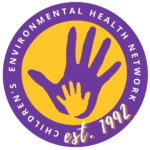Protecting Colorado Children’s Health
We are all reeling from the COVID-19 pandemic–grieving the loss of loved ones, of jobs, stability, social gatherings, and peace of mind. And we are struggling to adjust to our “new normal” amidst heightened anxiety and persisting uncertainties. One of the truly sobering takeaways is that this crisis has exposed critical gaps in our nation’s ability to effectively protect our most vulnerable. It is urgent that we act on preventable health outcomes to promote the safest and healthiest futures for our children.
That’s why I’m so excited about the new Colorado State Profile for Children’s Environmental Health from The Children’s Environmental Health Network (CEHN). CEHN is a national non-profit organization that has been at the frontlines of children’s environmental health for nearly three decades. They are developing profiles for each state around currently available children’s environmental health indicators (CEHIs).
Children’s Environmental Health & CEHIs
Over the past several decades, childhood chronic diseases, such as asthma and leukemias, and developmental conditions, such as attention-deficit-hyperactivity-disorder, have become far more common in the U.S. Improved testing and genetics do not account entirely for these worrisome trends.The World Health Organization estimates that 34% of all children’s health issues are the result of modifiable environmental factors.
Children are especially vulnerable to environmental exposures because they breathe, eat and drink more than adults, in proportion to their body size. Their bodies and brains are developing and thus at risk from toxic exposures, while in the womb through adolescence. Exposures to harmful toxicants in our water, food, and everyday products (such as lead, pesticides, brominated flame retardants, and PFAS) and to air pollutants (such as particulate matter, mercury, and ozone) increase children’s risk of adverse health and developmental outcomes and exacerbate existing health conditions. Children and pregnant women from low income communities, tribal communities, and communities of color are disproportionately exposed to these harmful toxicants, placing them at higher risk for illness and disability.
Our changing climate intensifies these environmental hazards and exacerbates existing inequalities–bringing stronger storms, extreme heat waves, more numerous and intense wildfires, and flooding. These effects and others threaten our air and water quality, food security, family and community stability, and physical and mental health. Climate change can also set the stage for more pandemics, as droughts and extreme temperatures increase our risks of zoonotic diseases. In the case of COVID-19, environmental factors can also influence a patient’s prognosis. Mounting scientific evidence demonstrates that exposure to air pollutants directly affects our ability to survive a virus that attacks our respiratory system, as is common with many emerging zoonotic diseases.
In order to reduce our children’s risk of illness and disability, federal, state, and local leaders need to address existing environmental hazards and better plan for children’s needs in the face of climate change. Unfortunately, the current federal administration is reversing nearly 100 environmental regulations that influence the health of our families and pose a serious threat to our impact on the climate. It is up to state and local officials to provide the environmental health protections that our children deserve. And it is up to us to speak out, demanding that children’s health be a priority.
For Colorado’s decision-makers to effectively address children’s environmental health concerns they must first understand the current state of these issues in their jurisdiction.Comprehensive information, including state-by-state comparisons of uniformly defined data points (CEHIs) about environmental hazards, environmental exposures, and relevant children’s health outcomes, is needed. Unfortunately there are very few accessible sources of robust, valid, and regularly updated state-level comparisons of CEHIs, but CEHN has compiled the most meaningful ones into their state profiles.
Colorado’s Profile
The Colorado profile offers interesting insights. The first thing that stuck out to me was that nearly 70% of Colorado children live in counties with unhealthy ozone levels as of 2020. Another 12% live in counties that either don’t monitor or have incomplete monitoring data for ozone pollution. That means that over 1 million of our 1.3 million Colorado children could be at risk for air-quality related health issues.
I was also startled that Colorado children are more likely than most in the U.S. to be drinking unclean water. The profile shows that 40% of all public water systems in Colorado reported violations of clean water standards (U.S. average is 31%). These reported violations include health-based violations (for example, exceedances of the maximum contaminant levels or exceedances of the maximum residual disinfectant levels), and monitoring and reporting violations.1
Clean air and water are such foundational human rights. They are at the root of our health and wellbeing. Our state is so rich in natural resources that people travel from all over the country to access our “pristine nature.” Why can’t we offer our children these very basic resources?
Indicators like access to clean air and water set the stage for other health related outcomes that can change the course of a child’s life forever. Mounting scientific research links environmental exposures with risk of Attention-Deficit Hyperactivity Disorder (ADHD), Attention-Deficit Disorder (ADD), and Autism Spectrum Disorder (ASD). In 2009, The President’s Cancer Panel’s Annual Report pointed to environmental causes for the worrying increase in the pediatric cancer rate since the ‘70s, which is now the leading disease-related cause of death past infancy in U.S. children. Poor outdoor air quality, including high concentrations of ground-level ozone, are linked with the exacerbation of children’s respiratory illnesses, including asthma, as well as the survivability of respiratory illnesses like COVID-19. These issues are all related. They all stem from the places in which our children play, live, and go to school, the food, water, clothes, and toys we give them, the ways in which we clean our homes, and what industries surround our neighborhoods.
As with the COVID-19 pandemic, our least privileged communities shoulder the worst of environmental hazards. Poverty is an important social determinant of health, and one that disproportionately affects indigenous communities and communities of color. As of 2019, 12% of Colorado’s children were living in poverty. They are less likely to be able to access quality health care, electrical power, nutritious food, and safe drinking water. They are also likely to live in unsafe homes and are more likely to learn, play, and live adjacent to polluting industries.
In addition, they are often left untested for associated exposures. For example, CEHN’s profile shows that 1% of Colorado’s children tested positive for elevated blood lead levels (BLL) in 2016, but if you read the footnotes you’ll see that only 6.6% of Colorado children under age 6 were tested. It’s also worth considering that not all children who are tested get reported to public health authorities, so the true scope of children’s lead poisoning in our state is likely higher. By the way, CEHN’s profile includes lots of helpful context, scientific studies, and links to more information, both in the report itself and on their website.
Developing comprehensive, uniformly-defined children’s environmental health indicators and regularly collecting and updating the data is critical to creating strong child-protective policies and to track our progress as we improve our children’s health. All of Colorado’s children deserve a safe and healthy environment to grow and develop. They need clean air to breathe and safe water to drink, nutritious food to eat, and healthy places in which to live, learn, and play. We know this is possible. In order to make it a reality we must hold our elected officials at all levels of government accountable and demand increased investment in under-resourced communities, in our crumbling infrastructure, and in our public health systems. We need to respect the interconnectedness of environmental and human health and prioritize the health of our planet so that our children and future generations have the healthiest possible start to life.
Looking for ways to get involved? Children’s Environmental Health Day is on October 8th this year. Demand that children’s health be put at the center of governmental issues: request a proclamation from Colorado’s governor or from your mayor. You can also host or join into a children’s environmental health day activity with your family, church, scout troop, or neighbors. Get ideas at www.cehn.org/cehday/









